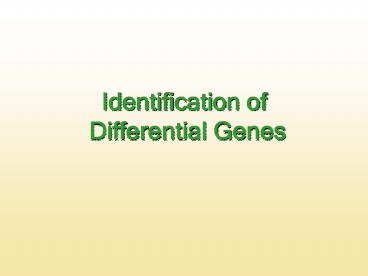Identification of Differential Genes PowerPoint PPT Presentation
1 / 21
Title: Identification of Differential Genes
1
Identification of Differential Genes
2
Identification of differential genes
- The most basic experimental design comparison
between 2 conditions treatment vs control - The goal to identify genes that are
differentially expressed in the examined
conditions - Number of replicates is usually low (n2-4)
3
Approaches for identification of differential
genes
- Fold Change
- T-test
- Cyber-T
- SAM
4
1. Fold Change
- Consider genes whose mean expression level was
change by at least 1.75-2 fold as differential
genes - Limits
- Usually no estimation of false positive rate is
provided - Biased to genes with low expression level
- Ignores the variability of gene levels over
replicates.
5
Fold Change limit Biased to low expression
levels
30
70
110
Determine floor cut-off according to estimate
of background level and set all expression levels
below it to this floor level
6
Fold Change limit ignores variability over
replicates
- Seek for score that punishes genes with high
variability over replicates
7
Approaches for identification of differential
genes
- Fold Change
- T-test
- Cyber-T
- SAM
8
2. T-test
- Compute a t-score for each gene
mc, mt mean levels in Control and
Treatment Sc2, St2 variance estimates in
Control and Treatment nc, nt number of
replicates in in Control and Treatment
9
T - test
- The t-score can be associated with statistical
significance (p-value) under the assumption that
expression levels follow normal distribution - Log-transformation
- Set cut-off for p-value (a0.01)
- Consider all genes with p-value lt a as
differential genes
10
Multiple Testing
- P-valg associated with the t-score Tg is the
probability for obtaining by random a t-score
that is at least as extreme as Tg. - Multiplicity problem thousands of genes are
tested simultaneously. - e.g. suppose
- 10,000 genes on a chip
- not a single one is differentially expressed.
- a0.01
- 10000x0.01 100 genes are expected to have a
p-value lt 0.01 just by chance.
11
Multiple testing
- Individual pvalues of e.g. 0.01 no longer
correspond to significant findings. - Need to adjust for multiple testing when
assessing the statistical significance of findings
12
Multiple Testing Bonferroni correction
- Consider as differential genes only those with
p-value lt (a/N) - N number of tests
- a0.01, N10,000 cut-off0.000001
- Ensure very low probability for having any false
positive genes (less than a) - Advantage very clean list of differential genes
- Limit the list usually contains very few genes
unacceptable high rate of false negatives
13
Multiple Testing FDR correction (Benjamini
Hochberg)
- False Discovery Rate
- In high-throughput studies certain proportion of
false positives is tolerable - Control the expected proportion of false
positives among the genes identified as
differential (q10). - Scheme
- Rank genes according to their p-vals
p(1)ltp(2)ltp(N) - Consider as differential genes the top k that
satisfy - p(i) lt i(q/N), 1ik
14
Approaches for identification of differential
genes
- Fold Change
- T-test
- Cyber-T
- SAM
15
3. Cyber-T (Baldi Long)
- Regularized t-test
- Problem Low number of replicates ? unstable
estimations of gene variances - Found that in microarray datasets, after
log-transformation, the variance is dependant on
the expression level - Lower expression level ? larger variance
16
- Utilize this rule to improve the estimation of
gene variances
- Lower expression level ? larger variance
In t-test, use s2 in place of s2 s2 genes
variance over the replicates n number of
replicates s02 expected variance given the
expression level of the gene ?0 weight of
s0 s02 estimated over a window of size 101
genes ?0 n 10
Log (expression)
17
Stabilization of the variance estimation
s2
s2
Log (expression)
Log (expression)
18
Cyber-T
- Regularized t-test performs better than the
conventional t-test when the number of replicates
is low (2-3) - By 5 replicates (5 control, 5 treatment) the
performances were similar
19
Approaches for identification of differential
genes
- Fold Change
- T-test
- Cyber-T
- SAM
20
4. SAM (Tusher, Tibshirani Chu)
- Significance Analysis of Microarray
- Limit of analytical FDR approach assumes that
the tests are independent - However in the microarray context, the expression
levels of some genes are highly correlated ?
unreliable FDR estimate - SAM uses permutations to get an estimate for the
FDR of the reported differential genes
21
SAM
- Scheme
- Compute for each gene a statistic that measures
its relative expression difference in control vs
treatment (t-score or a variant) - Rank the genes according to their difference
score - Set a cut off (d0) and consider all genes above
it as differential (Nd) - Permute the condition labels, and count how many
genes got score above d0 (Np) - Repeat on all possible permutations and count
(Npj) - estimate FDR as the proportion ltNpjgt/Nd
22
Permutation on condition labels
BACK

